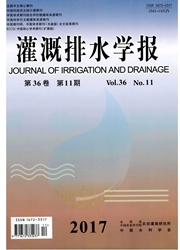

 中文摘要:
中文摘要:
为优选西北旱区制种玉米适宜的地面灌溉技术模式,对常规沟灌(CFI)、隔沟交替灌(AFI)和小畦灌(BI)制种玉米的生长指标、产量及水分利用效率进行了研究。结果表明。制种玉米生长期内,其株高的变化基本不受灌水量和灌水方式的影响;制种玉米干物质量变化速率最快的时期为灌浆-成熟期,且AFI可减少干物质累积量,从而减少植株生长过程中的冗余生长;AFI灌水量比CFI减小30.77%时,产量变化幅度为-1.38%~8.96%,其水分利用效率和灌溉水利用效率最大值分别为3.59kg/m^3和5.76kg/m^3,较CFI处理最高值提高6.96%和6.42%。CFI和AFl产量比B1分别提高9.68%~17.1%左右。隔沟交替灌溉是制种玉米田适宜的灌溉模式。
 英文摘要:
英文摘要:
Three irrigation methods, including conventional furrow irrigation (CFI), alternate-furrow irrigation (AFI) and small border irrigation (BI), were selected to investigate the effects of different irrigation methods on the growth index, yield and the water use efficiency of maize for seed. The results showed that in the growth period of maize, plant height was not affected by irrigation water amount and irrigation methods, and AFI had no impact on the growth of plants. The accumulation of aboveground biomass changed significantly from the postulation period to the mature period, and decreased under AFI, which could reduce the growth redundancy of crop. Compared with CFI, AFI could save water by about 30.77%, the change of yield ranged from -1.38% to 8.96%, the top water use efficiency and the top irrigation water use efficiency were 3.59 kg/m^3 and 5.76 kg/m^3 respectively, which were improved by 6.96% and 6.42%. Compared with BI, CFI and AFI increased yield by 9. 68% and 17. 1% respectively. In conclusion, application of AFI on corn for seed in the arid area have greater potentials in saving water and maintaining economic yield.
 同期刊论文项目
同期刊论文项目
 同项目期刊论文
同项目期刊论文
 期刊信息
期刊信息
